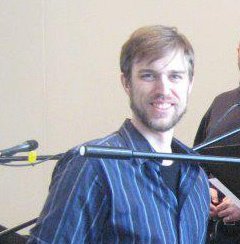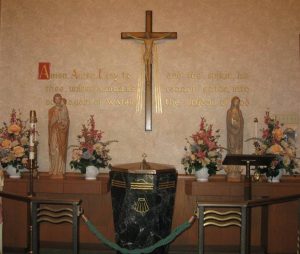Continuing on our blog series, here’s a witness story of David Augustine, parishioner, and former atheist and now converted Catholic. He talks about “what we believe,” and how the discovery of the sacraments was paramount in his discovery of Catholicism. David is now studying Liturgical Studies at the University of St. Mary of the Lake in Mundelein.
 I came to faith in Jesus Christ in late September 2004 after reading St. Matthew’s Gospel. I was 24 years old. I graduated from college the prior year and, up until that time, considered myself to be either an atheist or an agnostic, vacillating between the two. After encountering the risen Lord in the Gospel’s crucifixion narrative, I entered a Pentecostal church through some acquaintances and was baptized in November of that year. (This particular Church didn’t understand baptism to have any sacramental efficacy in the order of grace; it was an ordinance, completed in response to the Lord’s command to baptize. It was an outward sign of the inner renewal, i.e. the new birth, accomplished through the act of faith.)
I came to faith in Jesus Christ in late September 2004 after reading St. Matthew’s Gospel. I was 24 years old. I graduated from college the prior year and, up until that time, considered myself to be either an atheist or an agnostic, vacillating between the two. After encountering the risen Lord in the Gospel’s crucifixion narrative, I entered a Pentecostal church through some acquaintances and was baptized in November of that year. (This particular Church didn’t understand baptism to have any sacramental efficacy in the order of grace; it was an ordinance, completed in response to the Lord’s command to baptize. It was an outward sign of the inner renewal, i.e. the new birth, accomplished through the act of faith.)
I began my ten-month journey to the Catholic faith in November 2006 after I saw an episode of the Journey Home on EWTN. The guest, an evangelical convert named Leona Choy, struck me as spiritually credible; she spoke with gentle warmth and exuded the humility and patience I’ve long associated with Christian holiness. Her conversion stemmed from a period of personal study; as such, she recommended I pick up a book on the early Church Fathers called Four Witnesses by Rod Bennett. I went to my local Catholic bookstore under the cloak of darkness to buy it; the lady at the counter also gave me (free of charge) another book called No Price Too High by Deacon Alex Jones, a former Pentecostal preacher who had become a Catholic Deacon over in Michigan. His testimony was particularly relevant to me because of my Pentecostal background. Deacon Jones wrote in a way I could relate to, handling objections that I myself had, answering in advance many of the questions I was asking. These works, among others, served as my introduction to the worldview of the early church.
Thus it was that I set out of port from the safe and familiar harbors of Pentecostal Christianity onto yet another voyage of discovery through unknown waters. Unlike my earlier conversion, however, this one didn’t center on the person of Jesus or the validity of his message per se; these were already established facts for me. The question raised for me by the Fathers was: What is the Church? What does she look like? In their writings, I discovered – to my surprise – that the Church of the early centuries was both hierarchical and sacramental. She had a clearly defined visible power structure; she communicated God’s grace through visible channels called sacraments. This is a very tactile, Incarnational approach to “doing church”, very different from the ephemeral (transitory) ecclesiology I was accustomed to. No one had ever told me this!
To give just one well-known example of early Christian writing on the sacraments: In his First Apology, written shortly before 155 A.D., Justin Martyr gives a lengthy description of a 2nd Christian service held at Rome. Here’s how he describes the Eucharist:
“And this food is called among us eucharist, of which no one is allowed to partake except one who believes that the things which we teach are true, and has received the washing that is for the remission of sins and for rebirth, and who so lives as Christ handed down. For we do not receive these things as common bread nor common drink; but in like manner as Jesus Christ our Savior having been incarnate by God’s logos took both flesh and blood for our salvation, so also we have been taught that the food eucharistized through the word of prayer that is from Him, from which our blood and flesh are nourished by transformation, is the flesh and blood of that Jesus who became incarnate.” (Trans. by Leslie William Barnard, St. Justin Martyr: The First and Second Apologies, Ancient Christian Writers No. 56 (Mahwah, NJ: 1997), 70)
This is graphic language. It’s obvious that St. Justin explicitly associates the gifts transformed “through the word of prayer that is from Him” with the “flesh and blood of that Jesus who became incarnate”. But I could see how his understanding was derived from the deeds and sayings of Jesus in the New Testament. After all, the Institution Narrative – and the rite that it instituted – stands in need of some interpretation. Why not interpret it in light of John 6:56 (RSV):
“He who eats my flesh and drinks my blood abides in me, and I in him.” St. Justin also says that baptism confers “the remission of sins” as well as “rebirth”. But this too is consonant with New Testament teaching. On Pentecost, Peter preached a baptism “for the forgiveness of your sins; and you shall receive the gift of the Holy Spirit.” (Acts 2:38) Likewise, in John’s famous passage about being “born again”, Jesus taught, “unless one is born of water and the Spirit, he cannot enter the kingdom of God.” (Jo 3:5)
 Nevertheless, in spite of everything that I had read, my first experience of Mass was still rather comical. I went to an evening service at St. James, a beautiful but worn 19th century parish church in my hometown. An old brick building, it looks as if it was plucked right out of the Irish countryside by angels and planted in the new world. It was mid-winter and it was dark when I arrived. I remember feeling a bit like Martin Luther standing in front of the doors of the Castle Church at Wittenberg holding the Ninety-Five Theses. What was I doing? This was an alien world to me. Nonetheless, I eventually opened the large wooden doors and quietly slipped into the narthex, entering the world of Roman Catholicism.
Nevertheless, in spite of everything that I had read, my first experience of Mass was still rather comical. I went to an evening service at St. James, a beautiful but worn 19th century parish church in my hometown. An old brick building, it looks as if it was plucked right out of the Irish countryside by angels and planted in the new world. It was mid-winter and it was dark when I arrived. I remember feeling a bit like Martin Luther standing in front of the doors of the Castle Church at Wittenberg holding the Ninety-Five Theses. What was I doing? This was an alien world to me. Nonetheless, I eventually opened the large wooden doors and quietly slipped into the narthex, entering the world of Roman Catholicism.
Catholic worship has an ethos all its own, a way of looking at the world that is best experienced by walking around one of her places of worship. Reading about the Church was one thing; experiencing one of her services was another. I would love to tell my readers that I was carried aloft into heaven by my initial experience of Mass; mostly, I was just confused. Catholics stand, kneel and sit following a rhythm that immediately perplexes outsiders. Anyone watching me would have known I was a fish out of water, struggling to follow along. I didn’t know the structure of the Eucharistic Prayer yet, so I couldn’t follow what the priest was saying. I didn’t know the order of Mass, so I didn’t know what I was supposed to be doing either. There were statues everywhere. How was I supposed to feel about all this?
Despite everything, I was still taken by the experience. It felt somehow … real to me. It seemed to me that everything held a deeper significance that was simply waiting to be apprehended. I saw the priest standing at the altar, reverently speaking the Words of Institution into the bread and the chalice: “This is my body”, “This is the cup of my blood”.  I saw the statues of Sts. Peter (bearded man holding keys) and Paul (bearded man holding a sword) behind the altar. I saw the clusters of images of Sts. Mary and Joseph flanking the main altar on either side. In one mosaic icon, the gray-haired St. Joseph was suspended in a field of gold, holding the Christ child and a staff of lilies. In another – Our Lady of Perpetual Help – Mary holds the child Jesus by the hands while angels hover nearby bearing the instruments of his Passion. There was a large, sorrowful crucifix in the cry room.
I saw the statues of Sts. Peter (bearded man holding keys) and Paul (bearded man holding a sword) behind the altar. I saw the clusters of images of Sts. Mary and Joseph flanking the main altar on either side. In one mosaic icon, the gray-haired St. Joseph was suspended in a field of gold, holding the Christ child and a staff of lilies. In another – Our Lady of Perpetual Help – Mary holds the child Jesus by the hands while angels hover nearby bearing the instruments of his Passion. There was a large, sorrowful crucifix in the cry room.
The ethos of Catholic worship is, at times, very heavy; I’ve come to learn this is because it is worship embodied, worship made incarnate. The Church takes ordinary things out of our material creation – bread, water, wine, oil, and words – and makes them grace bearing. To our natural eyes, all is normal. But to eyes transformed by faith, heaven has opened and Christ is descending, offering us a foretaste in the here and now of his coming Parousia.
Ultimately, I came to the Catholic faith because I learned to see Jesus present in the worship of his Church, in her sacraments and sacramentals. I could see this idea was firmly anchored in the teaching of the New Testament. I could see as it developed in the teaching tradition of the Church down through the ages. And yes, with time, I’ve even
come to see it in the humble worship of my parish church. This type of “seeing” that comes from faith is a journey and my process of conversion is still ongoing. I suppose it won’t be complete until I see him face to face in the glory of the Resurrection.